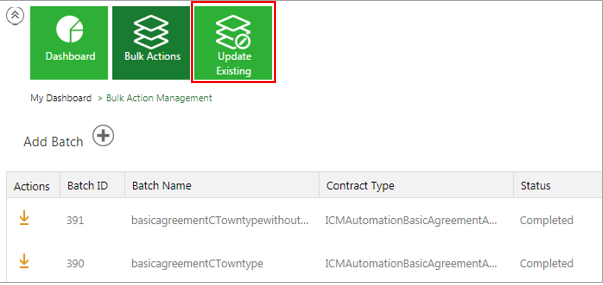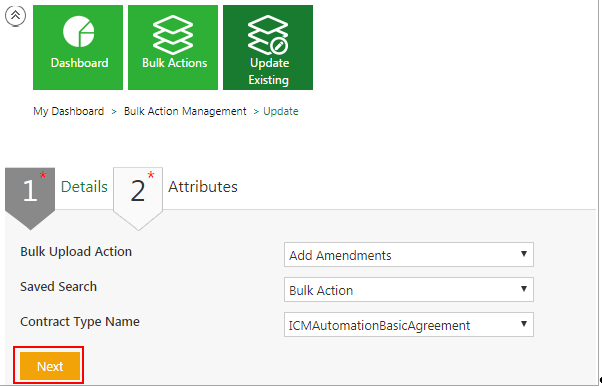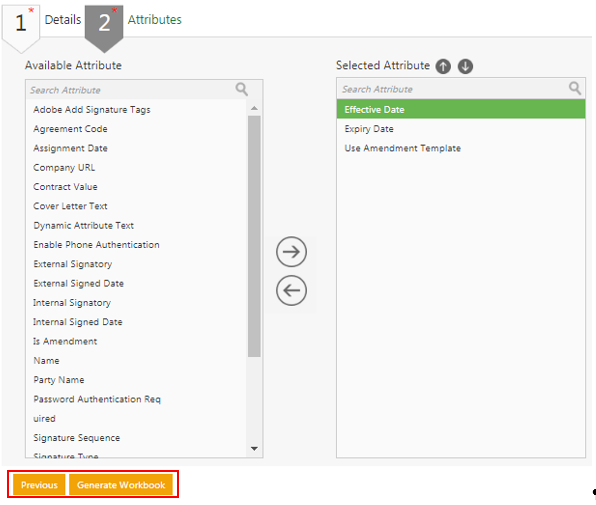| Line 19: | Line 19: | ||
#'''Click '''''[[User_Administration|User_Administration]] ''on the [[Dashboard|Dashboard]]. The ''[[User_Administration|User_Administration]] ''page opens. | #'''Click '''''[[User_Administration|User_Administration]] ''on the [[Dashboard|Dashboard]]. The ''[[User_Administration|User_Administration]] ''page opens. | ||
#'''Click '''''Security Groups ''on the ''User Administration ''page. The ''Security Group ''page opens. | #'''Click '''''Security Groups ''on the ''User Administration ''page. The ''Security Group ''page opens. | ||
| − | + | <div class="image-green-border">[[File:Enable Bulk Action Tile.png|Enable_Bulk_Action]]</div> <ol start="3"> | |
| − | + | <li>'''Click '''the icon next to the Security Group to open it. </li> | |
| − | + | <li><div class="image-green-border">'''Navigate '''to the ''Privileges ''section in the Security Group and search for ''Bulk Action ''under the ''Entity Name ''column. [[File:Edit Security Group.png|Edit-_Security_Group]]</div> </li> | |
| + | <li>'''Select '''''Bulk Action ''option under ''Manage ''or ''View ''column depending on whether you want to provide ''Manage ''or ''View ''privileges to the ''Bulk Action ''tile. The ''Bulk Action ''tile will be displayed on the Dashboard. </li> | ||
| + | </ol> | ||
The Bulk Action tile enables you to: | The Bulk Action tile enables you to: | ||
| Line 34: | Line 36: | ||
1. '''Click '''''Bulk Actions ''tile on the Dashboard. The ''Bulk Action Management ''page opens where you can update the existing entities by adding Amendments using the ''Update Existing ''tile. | 1. '''Click '''''Bulk Actions ''tile on the Dashboard. The ''Bulk Action Management ''page opens where you can update the existing entities by adding Amendments using the ''Update Existing ''tile. | ||
| − | |||
| − | |||
To add an Amendment: | To add an Amendment: | ||
| − | #'''Click '''''Update Existing ''on the ''Bulk Action Management ''page. The ''Update ''page opens. | + | #<div class="image-green-border">'''Click '''''Update Existing ''on the ''Bulk Action Management ''page. The ''Update ''page opens. \[[File:Update Existing Entities.PNG|Update_Existing_Entities]]</div> |
#'''Perform '''the following actions on this page and '''click '''''Next. '' | #'''Perform '''the following actions on this page and '''click '''''Next. '' | ||
<ul style="margin-left: 40px;"> | <ul style="margin-left: 40px;"> | ||
| Line 45: | Line 45: | ||
<li>Saved Search: You must have a Saved Search created before you can update any entity. '''Select '''the Saved Search from this drop-down, which shows all the Saved Searches by the logged on user and the global Saved Searches. </li> | <li>Saved Search: You must have a Saved Search created before you can update any entity. '''Select '''the Saved Search from this drop-down, which shows all the Saved Searches by the logged on user and the global Saved Searches. </li> | ||
<li>Contract Type Name: '''Select '''the Contract Type name from this drop-down. The user can view only those Contract Types that are associated with the Saved Search and to which the user has access. </li> | <li>Contract Type Name: '''Select '''the Contract Type name from this drop-down. The user can view only those Contract Types that are associated with the Saved Search and to which the user has access. </li> | ||
| − | |||
</ul> | </ul> | ||
| − | + | <div class="image-green-border">[[File:Update Existing Entities 1.PNG]]</div> | |
== Selecting the Attributes == | == Selecting the Attributes == | ||
| Line 58: | Line 57: | ||
#'''Select '''the Attributes from the ''Available Attributes ''list and move it to the ''Selected Attribute ''column. For example, ''Use Amendment Template. '''''Click '''''Yes ''when prompted to add parent Attribute. | #'''Select '''the Attributes from the ''Available Attributes ''list and move it to the ''Selected Attribute ''column. For example, ''Use Amendment Template. '''''Click '''''Yes ''when prompted to add parent Attribute. | ||
#'''Click '''''Generate Workbook. ''This generates and downloads the workbook with the system Attributes that are inherited as well the Attributes that you selected. | #'''Click '''''Generate Workbook. ''This generates and downloads the workbook with the system Attributes that are inherited as well the Attributes that you selected. | ||
| − | + | <div class="note-box">'''Note''': The file name of the downloaded workbook is the same as the Contract Type you selected on the ''Details ''page. </div> <div class="image-green-border"> </div> <div class="image-green-border">[[File:Generate Workbook.png|Generate_Workbook]]</div> <ol start="3"> | |
| − | '''Note''': The file name of the downloaded workbook is the same as the Contract Type you selected on the ''Details ''page. | + | <li><div class="image-green-border">'''Open '''the workbook that is downloaded and saved on your local drive. This workbook contains the information about the selected Attributes and Contract Type. [[File:View Workbook.png]]</div> </li> |
| − | <ol start="3"> | + | |
| − | <li>'''Open '''the workbook that is downloaded and saved on your local drive. This workbook contains the information about the selected Attributes and Contract Type. </li> | + | |
<li>'''Click '''the ''Enable Editing ''button on the Excel workbook (if required) to make changes as required.</li> | <li>'''Click '''the ''Enable Editing ''button on the Excel workbook (if required) to make changes as required.</li> | ||
</ol> | </ol> | ||
| Line 84: | Line 81: | ||
<li>If the ''Type of Paper ''is ''Third Party ''and ''File path'' column is left blank, the system uses the last approved version of the parent Agreement to add that Amendment.</li> | <li>If the ''Type of Paper ''is ''Third Party ''and ''File path'' column is left blank, the system uses the last approved version of the parent Agreement to add that Amendment.</li> | ||
</ul> | </ul> | ||
| − | |||
| − | |||
*Parent Agreement Status:This is a system-generated field the value of which should not be changed as it will result in an error. It indicates the status of the Agreement to which you are adding the Amendment. While adding an Amendment, the parent Agreement status will always be ''Executed.'' | *Parent Agreement Status:This is a system-generated field the value of which should not be changed as it will result in an error. It indicates the status of the Agreement to which you are adding the Amendment. While adding an Amendment, the parent Agreement status will always be ''Executed.'' | ||
| Line 98: | Line 93: | ||
| | ||
| − | + | <br/> | |
| − | + | ||
| − | + | ||
| − | + | ||
| − | + | ||
| − | + | ||
| − | + | ||
| − | + | ||
| − | + | ||
| − | + | ||
| − | + | ||
| − | + | ||
| − | + | ||
| − | + | ||
| − | + | ||
| − | + | ||
| − | + | ||
| − | + | ||
| − | + | ||
| − | + | ||
| − | + | ||
| − | + | ||
| − | + | ||
| − | + | ||
| − | + | ||
| − | + | ||
| − | + | ||
| − | + | ||
| − | + | ||
| − | + | ||
| − | + | ||
| − | + | ||
| − | + | ||
| − | + | ||
| − | + | ||
| − | + | ||
| − | + | ||
| − | + | ||
| − | + | ||
| − | + | ||
| − | + | ||
| − | + | ||
| − | + | ||
| − | + | ||
| − | + | ||
| − | + | ||
| − | + | ||
| − | + | ||
| − | + | ||
| − | + | ||
| − | + | ||
| − | + | ||
| − | + | ||
| − | + | ||
| − | + | ||
| − | + | ||
| − | | + | |
Revision as of 06:30, 5 February 2019
Bulk Actions
Users can perform bulk actions using the Bulk Actions tile on the Dashboard to create and update multiple entities directly within ICM. You can also perform these actions using Excel Add-in. When uploaded, these entities become part of the ICM workflow and can be managed within ICM itself.
Feature highlights:
- Optimal use of APIs and parallel processing for improved performance, thus allowing multiple users to add multiple batches of files simultaneously
- Eliminates the need of using a third party application such as Excel Add-in to upload entities in bulk
- Ability to select Attributes from ICM user interface (which is not possible when using Excel Add-in)
- Ability to check the number of valid Templates for an Amendment when using Own Type of paper
- Access control by providing visibility to the tile only to users with Manage privileges
- Provides error and status files for every batch processed. The status file indicates if the records passed or failed validation. The error file indicates the specific validation errors while processing the batch
You can enable the Bulk Action tile through the Security Groups.
To enable the Bulk Action tile:
- Click User_Administration on the Dashboard. The User_Administration page opens.
- Click Security Groups on the User Administration page. The Security Group page opens.
- Click the icon next to the Security Group to open it.
- Select Bulk Action option under Manage or View column depending on whether you want to provide Manage or View privileges to the Bulk Action tile. The Bulk Action tile will be displayed on the Dashboard.
The Bulk Action tile enables you to:
- Update Existing Entities, for example make changes to Agreements that are in Executed state.
- Populate the Workbook. You can use the same workbook to upload multiple Agreement records.
- Add a new Batch.
- Process the Batch
- View the Status and Error files.
To perform Bulk Actions:
1. Click Bulk Actions tile on the Dashboard. The Bulk Action Management page opens where you can update the existing entities by adding Amendments using the Update Existing tile.
To add an Amendment:
- Perform the following actions on this page and click Next.
- Bulk Upload Action: Select Add Amendments from this drop-down. This helps in adding an Amendment to an existing Agreement. You can add Amendments only to Agreements in Executed state.
- Saved Search: You must have a Saved Search created before you can update any entity. Select the Saved Search from this drop-down, which shows all the Saved Searches by the logged on user and the global Saved Searches.
- Contract Type Name: Select the Contract Type name from this drop-down. The user can view only those Contract Types that are associated with the Saved Search and to which the user has access.
Selecting the Attributes
While adding an Amendment to existing Agreement, you can select only the Attributes which you want to modify. Note that, values for non-editable as well as system Attributes such as Agreement Code cannot be selected. The metadata of the rest of Attributes is copied as is from the parent Agreement.
This page displays only Attributes related to Contract Type you have selected. You can select only the editable Attributes. If you select a dependent Attribute, the primary Attribute also gets selected by default. The Attributes selected on this page will be visible in the workbook you generate. For example, Effective Date and Expiry Date.
Follow these steps to select additional Attributes:
- Select the Attributes from the Available Attributes list and move it to the Selected Attribute column. For example, Use Amendment Template. Click Yes when prompted to add parent Attribute.
- Click Generate Workbook. This generates and downloads the workbook with the system Attributes that are inherited as well the Attributes that you selected.
- Click the Enable Editing button on the Excel workbook (if required) to make changes as required.
Populating the Workbook
The workbook that was generated in the previous step contains the Attributes you have selected as few additional system Attributes. You should see the following Attributes in this workbook:
- Parent Agreement Code: This is a system-generated field, the value of which should not be changed as it will result in an error. It contains the Agreement codes of the Agreements that are part of the Contract Type you selected.
- Effective and Expiry Dates: These are user-editable fields that are included in the workbook because we selected them while generating the workbook in the example above.
- Use Amendment Template: This Attribute plays an important role in selection of the Template while creating the Amendment. The system will:
- Either use the specified Template
- Or the last approved version of the Template in the parent Agreement
- Or auto-select a Template based on various combinations of this Attribute such as Type of Paper, Template Name and File Path Attributes.
User must select this Attribute on Attribute Selection page to achieve the desired result as mentioned below:
- If the Type of Paper is Own and a valid Template name is specified in the Template Name column, then system attaches that valid Template to the Amendment.
- If the Type of Paper is Own and Use Amendment Template is set to True and the Template Name column is blank, then the system automatically selects the valid Template. If there is exactly one Template applicable for the combination of the attribute metadata, the system automatically selects that Template to create an Amendment. If there are several valid Templates that are applicable, the system generates an error and provides a list of Templates to select from.
- If the Type of Paper is Own and Use Amendment Template is set to False and Template name column is left blank, the system selects the last approved version of the parent Agreement to create that Amendment.
- If the Type of Paper is Third Party and user specifies the file name in the File path column, that file is used to create that Amendment.
- If the Type of Paper is Third Party and File path column is left blank, the system uses the last approved version of the parent Agreement to add that Amendment.
- Parent Agreement Status:This is a system-generated field the value of which should not be changed as it will result in an error. It indicates the status of the Agreement to which you are adding the Amendment. While adding an Amendment, the parent Agreement status will always be Executed.
- Organization Unit: This is a system-generated field the value of which should not be changed as it will result in an error. It indicates the organization unit.
- Type of Paper: This is a mandatory and user editable Attribute. It can have either Own or Third Party as values.
- Template Name: This is a user-defined field. If the Type of Paper is Own ,the value in this field is considered while adding an Amendment.
- File Path: This is a user-defined (editable) field. If the type of paper is Third Party the value in this field is considered while adding an amendment. Specify the complete name of Agreement document including the file extension such as .pdf, .docx. The file name mentioned here must be part of the zip file you upload to ICM while adding a new batch.
- Action: You can use this field to specify the workflow action. In this release, only Create action is supported.
Information Sheet: System adds a default sheet named Information where you can find the general information about the upload action you have selected as well as the mapping of Contract Type name with sheet names. You should not make any changes to this sheet. After the records have been updated and the workbook is populated, you must create a zip file that contains all the files mentioned in the workbook including the file names mentioned under ‘file path’ column or the file names mentioned under attributes with File data type. This zip file is required for performing the next step of Adding a new Batch. The zip file can contain all the file formats supported by ICM and can be up to 100 MB in size.





